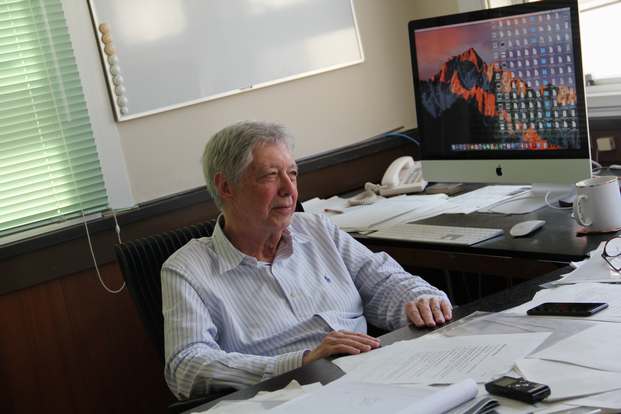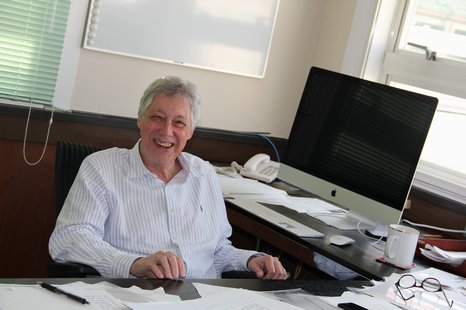SPECIAL REPORT: Discussion with Director in Charge of Scientific Advisory Committee Meeting
Included in this inaugural edition of our RERF email magazine “RERF E-News” is the following interview with Dr. Robert L. Ullrich, RERF Vice Chairman and Chief of Research, about our Scientific Advisory Committee (SAC) meeting, held each year over three days sometime in March. The Committee consists of outside experts from Japan and abroad who assess our research each year and provide recommendations about how to enhance our scientific activities and orient ourselves in specific directions. This year, the Committee met at Hiroshima RERF March 22-24.
In advance of this annual scientific meeting, sometimes as far as six months prior, scientists and administrators at RERF are busy with preparations for discussions and presentations designed to inform the Committee about our research.
Each year, after deliberations over the three days, the advisors formulate recommendations, based on which during the course of the next year RERF endeavors to enhance its science and prepare reports for the SAC the next year.
This formula of having outside specialists objectively grade our scientific attributes is necessary and beneficial. However, presenting your department’s research results, or your own papers, for example, can leave scientists tied in knots.
Q&A with Dr. Robert L. Ullrich, RERF Vice Chairman and Chief of Research
What were your impressions of this year’s (2019) Scientific Advisory Council meeting?
In all my time at RERF, since 2013, this was the best SAC meeting I’ve ever experienced. The reason was that the SAC members were all ‘incredibly engaged’ in the process of discussion and formulation of recommendations for our science.
Compared with last year’s advisor number of 13, this year we had 15 advisors: along with 10 regular SAC members from the U.S. and Japan, five Special Scientific Advisors were appointed, two more than were appointed last year. Among the five special advisors there were two such experts from the U.S. and one from Japan requested to facilitate the review of our Department of Molecular Biosciences (MBS), and one expert from the U.S. and two from Japan with expertise in integrated data resource and biobank operations appointed for the Research Resource Center (RRC) review. The RRC has been identified as the highest priority activity of RERF for its future success, resulting in the addition to the SAC this time of these experts in those particular fields.
External supervision of RERF’s research is one way to consistently break new ground. The Committee members can always be counted on to express their frank views about new directions RERF is thinking of moving and its unique studies based on such ideas.

Recalling his impressions about this year’s SAC meeting
What are the difficulties about the meeting from your, a scientist’s, perspective?
It just takes so long to do. Scheduling for the next year’s meeting begins at the current year’s meeting. Thereafter, all the preparations are begun in the September of that same year for the meeting the next March. Around February of the following year, all the preparations are completed and the presentations have to be rehearsed.
The MBS Department underwent a focused review this time. What was the result of that process?
The Department reported on its research as well as its strategic plans for the next five years. Truth be told, strategic planning is needed not only for the MBS Department but for the entire organization. The scientists gave effective presentations of their research, including such topics as the deleterious effects of radiation on the immune system of humans and how the influenza vaccine is affected by previous radiation exposure. MBS, and the entire organization, will receive formal recommendations from the SAC in the next few weeks based on those three days of meetings, and we all look forward to their frank opinions regarding our research operations.
How did the Biosample Research Center (BRC) fare under the review of the SAC?
The Biosample Research Center (BRC), under the leadership of Dr. Osamu Tanabe, BRC Director, received high praise for their work including the several workshops they held over the course of fiscal 2018. The BRC is one of the foundations for RERF’s success in the future. I have to say that recruiting Dr. Tanabe was crucial for continuing the improvement in quality of BRC work.
How does the phrase “We are one team” fit into your own image of RERF?
Well, that’s what it’s all about, isn’t it? That philosophy was actually one of the motivations for the development of our fairly new research cluster system. We wanted to transcend the conventional boundaries standing between researchers, and instead allow researchers from different departments interested in the same area of research to collaborate on a specific theme, without regard to departmental limitations.
We truly are working toward making our research more powerful as one team here at RERF. The department-specific work structure is now rather outmoded.
The SAC is one prime example in all our work during the year of how people can collaborate and join together to create something great as a collaborative research entity.
On a more personal note, what are some of the difficulties you’ve faced living in Japan?
The language issue. I still suffer from that, although things are getting better. You’re basically illiterate because you can’t speak so you can’t understand what people are saying. Besides that, though, everything is pretty easy and nice. I’ve never had any problem with the food, for example; I even eat natto (fermented soybeans).

Dr. Ullrich responds with a smile to questions amid busy schedule
How does this binational workplace differ from your work experiences in the U.S., including Oak Ridge National Laboratory, The University of Texas Medical Branch, Colorado State University; for Dr. Ullrich’s CV: https://www.rerf.or.jp/en/about/organization-en/manage/ullrich_e/.
In what is also a linguistic issue, cultural differences can lead to misunderstanding, because communication in Japan is not as linear. In the U.S., communication can be so damn direct-even English is a direct language. In Japan, conversely, communication seems more indirect and not as transparent. Sometimes the different styles make it tough for my understanding.
Ms. Tomoe Sugiyama is charged with organizing some of the work that takes place behind the scenes to ensure that the SAC meeting runs smoothly. While she remains out of the spotlight, her efforts are very much front and center. See her interview on the top page of E-News.
